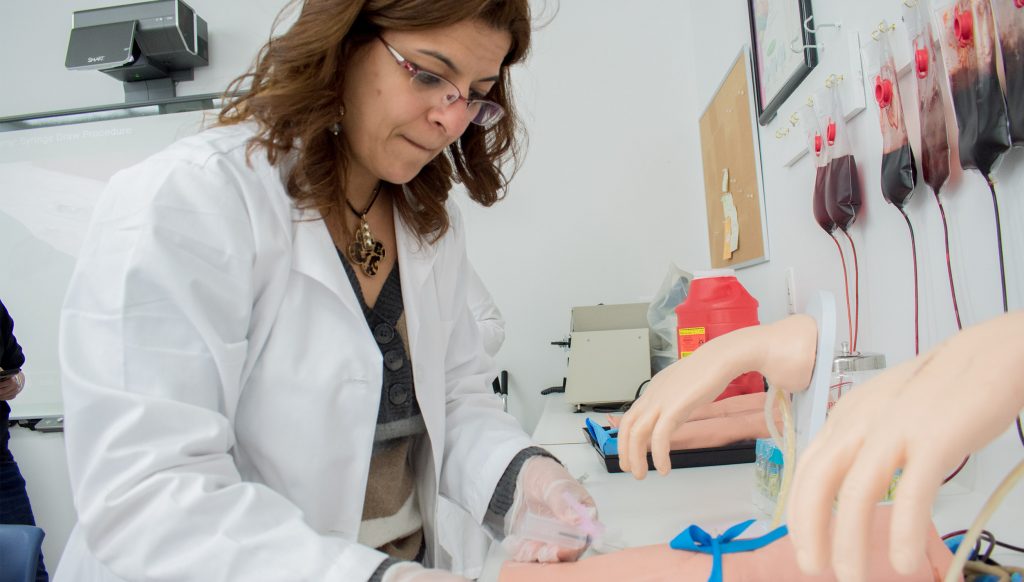If you’re looking to make a career change, you might want to start thinking about how you’d look in a pair of medical scrubs.
By 2024, 2.3 million new jobs are expected in healthcare, according to recent figures from the Bureau of Labor Statistics: that’s nearly one in four of every new job opening in the next eight years. At the same time, employers are reporting difficulty finding enough qualified applicants for these jobs. This all adds up to a historic healthcare professional shortage.
Medical colleges in particular have their eye on this trend, as they are likely to see demand for their programs increase in the coming years as more people realize the value a medical education will have in the coming years. This is especially true locally, where there are a limited number of medical schools within a reasonable driving distance for many, which could see waitlists for class seats.
“We’re certainly expecting to see a big jump in applications and potentially longer waitlists for classes,” explains Thomas M. Eastwick, President of Eastwick College. “We’re one of the few medical colleges in the area that guarantees clinical rotations to our medical students, which makes us an especially popular option as clinicals are critical to actually starting a career in the field.”
Of course, shortages in healthcare are nothing new. The U.S. healthcare system has been experiencing them for the past decades to varying degrees. But the shortage just over the horizon is likely to be of an unprecedented magnitude. Researchers at Vanderbilt University wrote in a 2009 paper that the 2025 nursing deficit would be more than twice as large as any shortage experienced since the introduction of Medicare and Medicaid in the mid-1960s.
So what is causing this shortage? One major factor: there are more people, and more of those people are reaching old age. The U.S. Census Bureau predicts that the total population will have grown by 50 million between 2006 and 2025. And the number of elderly is also increasing: 70 million residents, or 20 percent, will be 65 or older by 2030. In fact, there are more Americans over the age of 65 today than at any other time in U.S. history. This has a significant impact on the healthcare system, as that demographic uses twice as many physician resources as those under 65. In addition, many nurses and healthcare professionals are aging as well, with more than 500,000 nurses projected to retire or leave the labor force by 2022.
For patients, this might mean longer waiting times for appointments, shorter time spent with physicians, and higher costs. But for those that choose to pursue a position in healthcare, the shortage is also an incredible opportunity to not only help stem these negative impacts, but also build a secure, fulfilling career in the process. A study by AMN healthcare in 2013 found that nearly two-thirds of all hospital executives said that they will need more nurses at their facilities and half said they expect to increase the number of nurse practitioners in the next six months. And this increase in opportunities isn’t limited to just nurses: the U.S. Bureau of Labor Statistics reports that new jobs for occupational therapy assistants will increase by more than six times the national average for all occupations, an incredible spike in demand. And they also report significant increases for other medical professions, such as medical assisting, surgical technology, and sonography. Again, one of the biggest factors for job seekers won’t be finding a medical career that’s in demand, but a school in the area that offers it.
“We were the first to develop an occupational therapy assistant degree in the state, and we’re still only one of only two schools in the area that offer it. Many of our other medical programs are unique for the area as well, whether that’s in the certifications our students can sit for or the accreditations that back up the curriculum,” adds President Eastwick. “There really aren’t all that many medical schools in the area that offer the level of training and education that employers expect and that we provide.”
For more information on the job outlook for specific healthcare careers you can visit the U.S. Department of Labor’s Bureau of Labor Statistics “Occupational Outlook Handbook.” Eastwick College offers a wide range of medical programs at its campuses – located in Ramsey, Hackensack, and Nutley – including licensed practical nursing (LPN), registered nurse (RN), cardiovascular sonography, surgical technology, occupational therapy assistant (OTA), medical assisting, medical billing and coding, and health science. To learn more about Eastwick College and the unique medical programs it offers, visit eastwick.edu.

